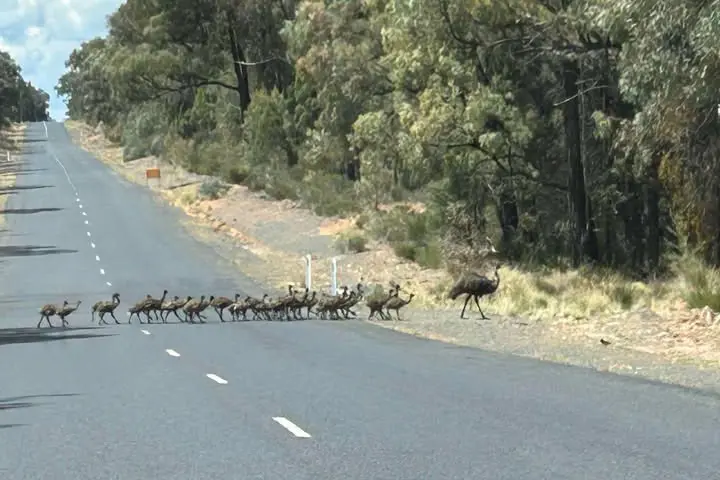PHOTO
A photo posted on the Dubbo Photo News Facebook page last week depicting an adult emu leading more than 20 chicks across a rural central west road has garnered more than 1.7 million views and generated interesting debate among readers.
Snapped by Dubbo resident Sue Gilchrist on Wednesday, October 30, as she was travelling between Dubbo and Mendooran with husband Ben as part of a longer trip to Sydney, the photo was sent to Dubbo Photo News and subsequently posted to our Facebook page on Sunday, November 2. It quickly went viral.
At the time of writing more than a week later, the post has been viewed 1.7 million times and generated almost 20,000 likes, 2000 comments, and 1500 shares.
The reaction to the photo, including the thoughts of readers who weighed in on the legitimacy of the photo, the sex and behaviour of the adult emu and the number of chicks following along, has led us to investigate further and answer some of the key questions.
Dubbo Photo News has interviewed the quiet and unassuming Sue Gilchrist, 57, who is very surprised that her travel snap has gone viral.
“It's just a shame that it wasn't a better picture,” she said, saying there was a rush to get photos on their phones as it happened. The event was also recorded on their car’s dashcam, which recorded over the footage on their return from Sydney.
“We were in such shock and awe at what we were seeing. To see that many chicks, it was a once in a lifetime experience.”
The photo, which Dubbo Photo News has verified, was taken on the Dubbo to Mendooran road, near the Goonoo Forest at 2pm on October 30.
“We were going to Sydney for a few days and I used to live in Mendooran, so I know the road quite well,” she added.
The Gilchrists stopped for the procession and said it was lucky there were no other vehicles on the road at the time so that the young flock could cross safely. After crossing the road, the mob scattered into the bush, Ms Gilchrist said.
“They stayed basically in a line while they were crossing the road, and then they just scattered into the bush with dad. It was quite funny,” she said.
“Like some people have said, it looks like the school master and the kids following behind. You know, that's exactly what it was.”
Intrigued, Sue did some research on emus later that night.
“I said to Ben, it's not possible that he's got that many babies. He could never have sat on that many eggs. That night, I Googled it, and I read that they do adopt orphaned emus. And I thought, oh, that's lovely,” Ms Gilchrist explained.
Some Dubbo Photo News readers also wondered about the number of chicks, which can’t be clearly counted but number at least 20, and if the emu was indeed male.
Dubbo Photo News reached out to Taronga Western Plains Zoo for further information about Australia’s giant flightless bird, and spoke with emu keeper Lou Todd.
Ms Todd, who is the keeper for native animals at the zoo, confirmed that males do incubate the eggs and spend several months raising the young. She said it is “entirely possible” that one male adult could be caring for more than 20 chicks.
“Typically, the clutch size of an emu nest sits at around five to 15 eggs, sometimes 20-plus,” Ms Todd said.
“But what we do sometimes see from emus when they're breeding is multiple females laying in the same nest.
“So that means we can get massive, massive clutches, but we can also see males adopting other chicks as well,” she added.
She estimates that the chicks in the viral photo could be about a month or so old.
Ms Todd said male emus do “a pretty spectacular job as fathers”, incubating the eggs in the clutch for around 56 days and going without sustenance or leaving the nest for a lot of that time.
“Once the eggs hatch, [the males] protect those chicks very much with their life. They're very, very protective of those little bubs, and they stay with them, protecting them for up to seven months,” she added.
“So if [the male] comes across some lost chicks and no other male is around to look after them, and the chicks are at a similar growth stage to his chicks, he may just adopt them into his flock and look after them as well as his own.”
With emus breeding over winter, now is the time of year when they will be spotted out and about with their growing chicks, she added, cautioning motorists to look out for wildlife on rural roads.
Emus can travel up to 25km per day looking for food and water and this will, on occasion, bring them to roadways, Ms Todd said.
Already in 2025, over 600 wildlife cases have come through the doors at Taronga Wildlife Hospital, a zoo spokesperson said. Five of those were emus, two of which did not survive. One of the leading causes of injury for wildlife cases is collision with motor vehicles.
“If you come across injured wildlife, contact your local wildlife rescue organisation or bring them to the Taronga Wildlife Hospita,l where they can be assessed and treated by our expert team of wildlife veterinary staff,” the spokesperson said.
The Taronga Western Plains Zoo Wildlife Hospital is open from 8.30am to 4.30pm, seven days a week.





